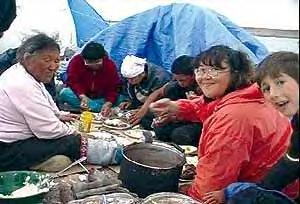|
|
Canku Ota |
|
|
(Many Paths) |
||
|
An Online Newsletter Celebrating Native America |
||
|
September 8, 2001 - Issue 44 |
||
|
|
||
|
First We Take Tasiujaq, then We Take the World |
||
|
by Alison Blackduck-Nunatsiaq News-August 31, 2001 |
||
|
Nunattini participants take a meal break.-Photo courtesy of Nunattini Web Site |
 IQALUIT
— A coordinator of the ambitious new Nunatinnit Nomadic Media Lab says the vagaries of weather still trump the
power of the Internet. IQALUIT
— A coordinator of the ambitious new Nunatinnit Nomadic Media Lab says the vagaries of weather still trump the
power of the Internet."Our main obstacles were never technical obstacles," Katarina Soukup said in a telephone interview from Igloolik. For five days, a trilingual group of Inuit and non-Inuit, young and old, used a satellite uplink to the Internet to share their experiences of living on the land. "Our main obstacle was actually the environment we were in, because the weather affected everything. The weather delayed our trip two or three days when we went out. The weather delayed the arrival of one of our guests and prevented Zacharias Kunuk from even coming... so the obstacles were really more natural than technical." Members of Igloolik’s Arnait Video Productions built the Web site as a continuation of Anana, a yet-to-be released documentary about Igloolik’s Kunuk family. Beginning Aug. 15, the group of 20 people Web cast the "sights and sounds" of the Kunuk family’s summer outpost — such as Vivi Kunuk telling a multi-part series about cannibalism and man-eating insects, and Martha Nagmalik making bannock. The Kunuk camp is located in Nagjuktaqtuyuk, located in Tasiujaq, a popular northwestern Baffin Island hunting region two hours by boat from Igloolik. The Web cast ended Aug. 19. "It was very successful," Soukup says. "Before we did it, I wasn’t sure how easy it would be to use the satellite phone, but it turned out to be very simple to use and the equipment worked out well." Stratos Global Communication, a Canadian telecommunications company, loaned the satellite phone to the media lab. Soukup says media lab members initially felt anxious about using the phone because their satellite connections cost $7.50 per minute. The lab budgeted $10,000 to pay for airtime. However, Soukup says the connection’s high speed reduced the amount of money spent on airtime. "We couldn’t have really heavy media files, so we limited ourselves to doing one minute video and audio and making them about one megabyte in size. That enabled us to upload things really quickly, and on your end download them really quickly. "We knew that we wanted a lot of people in the North to see it, and the Internet connections in the North are really slow, so we didn’t want to make it too inaccessible for people who wanted to see it in Nunavut or the Northwest Territories." Soukup says the lab also had to consider sources of energy that were transportable and reliable. "We used a gas generator to power everything, but I think if we do it again next year I’d like to try it with alternative sources of energy like solar panels, wind turbines and things like that." The event was such a success that Zacharias Kunuk is now dreaming of a truly nomadic television network roaming the tundra. Speaking in an interview available on the Web site, Kunuk states: "We could put a TV network just out there and broadcast daily with editing rooms. Why do we have to do it in Igloolik? "The world is so globalized: we can go anyplace and talk on a cell phone, but up here you still can’t. But it’s coming." You can view the web-site at http://www.nunatinnit.net |
|
|
|
Nunatinnit Net |
|
|
||
|
|
||
| Canku Ota is a free Newsletter celebrating Native America, its traditions and accomplishments . We do not provide subscriber or visitor names to anyone. Some articles presented in Canku Ota may contain copyright material. We have received appropriate permissions for republishing any articles. Material appearing here is distributed without profit or monetary gain to those who have expressed an interest. This is in accordance with Title 17 U.S.C. section 107. | ||
|
Canku Ota is a copyright © 2000, 2001 of Vicki Lockard and Paul Barry. |
||
|
|
|
|
|
The "Canku Ota - A Newsletter Celebrating Native America" web site and its design is the |
||
|
Copyright © 1999, 2000, 2001 of Paul C. Barry. |
||
|
All Rights Reserved. |
||

